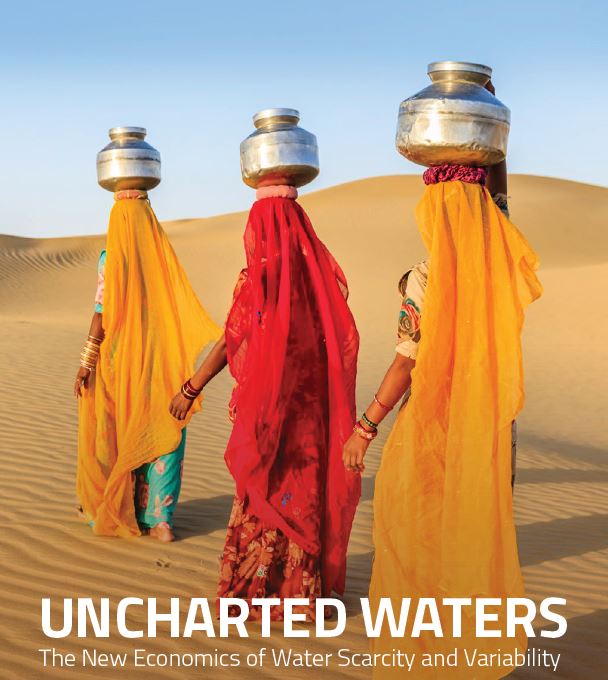Uncharted Waters, the New Economics of Water Scarcity and Variability
When the rains withered and the forests turned into parched savannahs, the earliest humans drifted out of Africa in their quest for water. Farms, settlements, and eventually cities clustered along riverbanks and gave rise to great civilizations. Now, as then, economic activity remains tied to water availability. But this relationship will undergo unprecedented pressures, as the 21st century witnesses the collision of two powerful forces— burgeoning population growth, together with a changing climate. With population growth, water scarcity will proliferate to new areas across the globe. And with climate change, rainfall will become more fickle, with longer and deeper periods of droughts and deluges. Erratic rains weigh heavily on communities and economies. Floods are so powerful a metaphor of the human experience that nearly every civilization—from classical antiquity, to the Abrahamic religions, to ancient Mesopotamia—tells of a deluge epic that changed the world. Although it is debated whether these myths have a basis in historical events, extreme weather events still reshape societies and permanently mark the lives of those who experience them. Over the past two decades, extreme rainfall events have affected about 300 million people on average every year. With climate change, such extreme episodes of rainfall are expected to increase in frequency. Adapting to changing trends in rainfall, although difficult in its own right, is a gradual and predictable process. Knowing how to address unpredictable rainfall shocks, of uncertain frequency and unknowable magnitude, presents an additional challenge brought by climate change. Whereas floods are spectacular weather events that cause sensational damage, droughts are misery in slow motion with impacts that are deeper and longer lasting than previously believed. Although overflowing riverbanks and storm surges certainly pose major economic threats, this book demonstrates that the impacts of water scarcity and drought may be even greater, causing long-term harm in ways that are poorly understood and inadequately documented. Droughts can have health impacts, hamper firm productivity, accelerate the destruction of forests, and compromise agricultural systems. This book presents new evidence to advance understanding on how rainfall shocks coupled with water scarcity impact farms, firms, and families. On farms, the largest consumers of water in the world, impacts are channeled from declining yields to changing landscapes. In cities, water extremes, especially when combined with unreliable infrastructure, can stall firm production, sales, and revenue. At the center of this are families, who feel the effects of this uncertainty on their incomes, jobs, and longterm health and welfare. Parched Farms, Shriveling Yields, and Shrinking Forests Throughout much of the world, even moderate deviations from normal rainfall levels can cause large changes in crop yields. The driest regions are most sensitive to rainfall variability, although extreme rains can also bring crop losses to regions with more bountiful precipitation and productivity. Such variability is responsible for a considerable net loss of food production every year—enough to feed 81 million people every day, a population the size of Germany’s. Many of the affected regions overlap with areas that are already facing large food deficits and are classified as fragile, heightening the urgency of finding and implementing solutions. Rainfall shocks cascade consequences from declining agricultural yields to shrinking forest cover. Faced with declining agricultural productivity due to rainfall shocks, farmers often seek to recoup these losses by expanding cropland, at the expense of natural habitats. Rainfall variability can account for as much as 60 percent of the increase in the average rate of cropland expansion, and, as a result, is responsible for much of the pressure on forested areas. Climate change may accelerate this pattern, leading to a harmful cycle where rainfall shocks induce deforestation, thereby increasing carbon dioxide emissions, and, in turn, further exacerbating rainfall extremes. Irrigation systems usually insulate agriculture from the adverse effects of rainfall variability, but these systems may also paradoxically amplify the impacts of shocks. The availability of irrigation typically provides both a buffer against rainfall variability and a significant boost to crop yields in normal years. However, in many dry regions of the world these systems fail to protect farmers from the impacts of droughts. Free irrigation water creates the illusion of abundance, which buoys the cultivation of water-intensive crops such as rice and sugarcane that are ultimately unsuited to these regions. The ironclad laws of demand and supply then dictate that when water is provided too cheaply, it is also consumed recklessly. As a result, crop productivity suffers disproportionately in times of dry shocks due to extraordinary water needs that cannot be met. This book demonstrates that this paradox of supply is a widespread problem in areas where water is scarce and its demand is uncontrolled.
